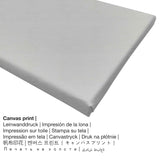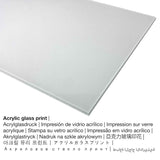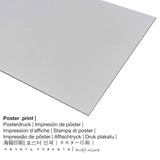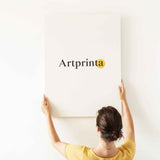Toby Edward Rosenthal, 1883 - Proces Constance de Beverly - druk artystyczny
Podatek jest wliczony. Koszt wysyłki zostanie obliczony W kasie.
Materiały, które mogą wybrać nasi klienci
The product dropdown menu gives you the chance to select your prefered size and material. Thus, we allow you to choose among the following options:
- Druk na płótnie: The canvas direct print is a printed canvas stretched on a wooden frame. It creates a sculptural effect of three-dimensionality. Hanging your canvas print: The great advantage of canvas prints is that they are relatively low in weight, which implies that it is quite simple to hang up your Canvas print without any wall-mounts. That is why, canvas prints are suited for all kinds of walls.
- Nadruk dibond aluminiowy (metal): An Aluminium Dibond print is a material with an outstanding depth - for a modern look and a non-reflective surface. A direct Aluminium Dibond Print is the best introduction to art reproductions manufactured on aluminum. For our Print On Aluminum Dibond, we print your selected work of art onto the aluminium white-primed surface. This print on Aluminum Dibond is the most popular entry-level product and is a stylish way to display art reproductions, because it puts the viewer’s focus on the replica of the artwork.
- Wydruk plakatu (materiał płócienny): The poster print is a UV printed canvas with a fine surface texture. It is excellently appropriate for putting your art print using a custom-made frame. Please bear in mind, that depending on the absolute size of the canvas poster print we add a white margin 2-6 cm round about the print motif, which facilitates the framing with your custom frame.
- Obraz na szkle akrylowym (z powłoką z prawdziwego szkła): The print on acrylic glass, often referenced as a UV print on plexiglass, will transform the original into wonderful wall décor and forms a viable alternative to canvas and dibond fine art replicas. Our acrylic glass protects your selected art print against light and external influences for between 4 and 6 decades.
Ważna uwaga prawna: We try the best we can to depict the art products as clearly as possible and to illustrate them visually. Nonetheless, the colors of the print products, as well as the imprint may diverge slightly from the representation on the screen. Depending on your settings of your screen and the condition of the surface, color pigments might not be printed as realisitcally as the digital version shown here. In view of the fact that all our are printed and processed manually, there may also be minor variations in the motif's exact position and the size.
Original information about the work of art by the museum (© - by Los Angeles County Museum of Art - www.lacma.org)
Notes from the Curator: American art achieved cosmopolitan status in the decades following the nation’s centennial with figure paintings such as The Trial of Constance de Beverly by Toby Rosenthal (1848-1917). Although a scene set in the time of Henry VIII (1491-1547) the large canvas resonates of the 19th century and serves as a barometer of cultural taste. Rosenthal was one of the earliest American expatriate artists to achieve international fame. Prussian-born, he grew up in San Francisco but returned to Europe to enroll in the Royal Academy in Munich. There he was introduced to the academic belief in the superiority of history painting. Under Karl von Piloty, Rosenthal learned how to depict stories of an uplifting, moral character in dramatic, yet easily understood terms. While he lived in Germany, Rosenthal received his most significant commissions from Americans. In 1879 the San Francisco industrialist Irving M. Scott requested a scene from Marmion (1808), a romantic narrative poem by Sir Walter Scott (1771-1832). The tale was a favorite of Rosenthal’s patron, whose enthusiasm reflected the popularity of the Scotsman’s writings with the middle-class reading public. Scotts’ influence on 19th-century pictorial arts was equally pervasive, for beginning in the 1820s, his novels revolutionized history painting in Europe and America by providing artists with stories of a human character that had mass appeal. The Trial of Constance de Beverly was a late example of such painting. Marmion is a tale fraught with all the elements of a bestseller: romance, danger, abandonment, and death. The story concerns Constance de Beverly, a beautiful young novice who is seduced into leaving the convent by Lord Marmion, a handsome but eventually faithless suitor. Rosenthal chose not to delineate a romantic episode, but to focus on the tense courtroom drama as Constance awaits her fate at the hands of a clerical tribune. In quite operatic fashion befitting medieval revival novels and history paintings, Rosenthal depicted the moment when a monk plucks Constance’s cloak from her shoulders to reveal her clothed as Lord Marmion’s page: in the background two monks gleefully prepare the niche where she will be bricked-up alive for breaking her religious vows. Rosenthal brilliantly exploited the romantic elements of gothic literature by heightening the sinister, almost ghoulish character of the scene through a cavernous setting, brownish-black palette, tenebrous lighting, and theatrical facial expressions. Rosenthal sought complete accuracy in the details of the setting and costume. He did depart dramatically from the story, however, by omitting Lord Marmion from the trial scene. By doing so, Constance becomes the main protagonist, standing center stage, a heroine despite the tragedy of her situation. Painted during a period when most women still had little control of their own lives, Rosenthal’s Constance was someone who determined her own destiny. After winning a gold medal at the 1883 Munich International Art Exhibition, the painting was exhibited in San Francisco to great acclaim.
Notes from the Contributor: Painting by Toby Edward Rosenthal (Museum: Los Angeles County Museum of Art)
Wyjaśnienie produktu artystycznego
Ta grafika została wykonana przez Toby'ego Edwarda Rosenthala in 1883. Oryginał mierzy rozmiar 57 5/8 × 91 cali (146,37 × 231,14 cm) and was painted with the techinque of oil on canvas. Today, this work of art is in the the digital collection of Los Angeles County Museum of Art. With courtesy of Los Angeles County Museum of Art (www.lacma.org) (public domain).Also, the artpiece has the creditline: . On top of that, alignment is in krajobraz format ze stosunkiem 3: 2, co oznacza, że długość jest o 50% dłuższa niż szerokość.
Strukturalne szczegóły dzieła sztuki
| Tytuł dzieła: | "The Trial of Constance de Beverly" |
| Kategoryzacja: | malarstwo |
| Termin ogólny: | sztuka współczesna |
| Wiek sztuki: | 19th wieku |
| Utworzony w roku: | 1883 |
| Wiek dzieł sztuki: | więcej niż 130 lat |
| Malowane na: | olej na płótnie |
| Wymiary oryginalnej grafiki: | 57 5/8 × 91 cali (146,37 × 231,14 cm) |
| Muzeum: | Los Angeles County Museum of Art |
| Miejsce muzeum: | Los Angeles, Kalifornia, Stany Zjednoczone Ameryki |
| Strona internetowa: | Los Angeles County Museum of Art |
| Licencja: | domena publiczna |
| Dzięki uprzejmości: | Muzeum Sztuki Hrabstwa Los Angeles (www.lacma.org) |
O tym produkcie
| Kategoryzacja artykułów: | kopia sztuki |
| Metoda rozmnażania: | reprodukcja cyfrowa |
| Technika produkcji: | Druk bezpośredni UV (druk cyfrowy) |
| Produkcja: | Made in Germany |
| Rodzaj akcji: | produkcja na żądanie |
| Przeznaczenie produktu: | dekoracja ścienna, galeria reprodukcji dzieł sztuki |
| Orientacja grafiki: | formacie poziomym |
| Format obrazu: | 3: 2 |
| Interpretacja proporcji obrazu: | długość jest o 50% dłuższa niż szerokość |
| Materiały do wyboru: | wydruk plakatu (papier płócienny), wydruk na płótnie, wydruk w metalu (dibond aluminium), wydruk na szkle akrylowym (z powłoką z prawdziwego szkła) |
| Opcje płótna na krośnie (wydruk na płótnie): | 30x20cm - 12x8", 60x40cm - 24x16", 90x60cm - 35x24", 120x80cm - 47x31" |
| Warianty wydruku na szkle akrylowym (z powłoką z prawdziwego szkła): | 30x20cm - 12x8", 60x40cm - 24x16", 90x60cm - 35x24", 120x80cm - 47x31" |
| Opcje rozmiaru wydruku plakatu (papier płócienny): | 60x40cm - 24x16", 90x60cm - 35x24", 120x80cm - 47x31" |
| Opcje druku Dibond (materiał aluminiowy): | 30x20cm - 12x8", 60x40cm - 24x16", 90x60cm - 35x24", 120x80cm - 47x31" |
| Oprawa kopii artystycznej: | nieoprawione wydruki artystyczne |
Stół artysty
| Imię artysty: | Toby'ego Edwarda Rosenthala |
| Inne nazwy: | rosenthal toby e., toby e. rosenthal, Rosenthal Tobias Edward, tobi e. rosenthal, toby rosenthal, Rosenthal Toby Edward, Toby Edward Rosenthal, t.e. rosenthal, Rosenthal Toby |
| Płeć artysty: | zły |
| Narodowość artysty: | amerykański |
| Zawody: | artysta, malarz |
| Kraj pochodzenia: | United States |
| Klasyfikacja artystów: | współczesny artysta |
| Życie: | 69 roku |
| Rok urodzenia: | 1848 |
| Miejsce urodzenia: | Prusy, Europa |
| Zmarł w roku: | 1917 |
| Zmarł w (miejsce): | Berlin, kraj związkowy Berlin, Niemcy |
Prawa autorskie © | www.artprinta.com (Artprinta)














